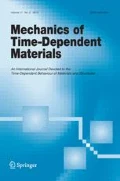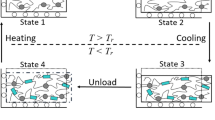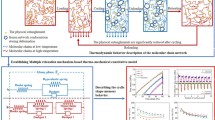Abstract
In this study, we explore the influence of mechanically-induced dilatation on the thermomechanical and shape memory behavior of amorphous shape memory polymers (SMPs) at large deformation. The uniaxial tension, glass transition, stress relaxation and free recovery behaviors are examined with different strain levels (up to 340% engineering strain). A multi-branched constitutive model that incorporates dilatational effects on the polymer relaxation time is established and applied to assist in discussions and understand the nonlinear viscoelastic behaviors of SMPs. It is shown that the volumetric dilatation results in an SMP network with lower viscosity, faster relaxation, and lower \(T_{g}\). The influence of the dilatational effect on the thermomechanical behaviors is significant when the polymers are subject to large deformation or in a high viscosity state. The dilation also increases the free recovery rate of SMP at a given recovery temperature. Even though the tested SMPs are far beyond their linear viscoelastic region when a large programming strain is applied, the free recovery behavior still follows the time-temperature superposition (TTSP) if the dilatational effect is considered during the transformation of time scales; however, if the programming strain is different, TTSP fails in predicting the recovery behavior of SMPs because the network has different entropy state and driving force during shape recovery. Since most soft active polymers are subject to large deformation in practice, this study provides a theoretical basis to better understand their nonlinear viscoelastic behaviors, and optimize their performance in engineering applications.














Similar content being viewed by others
References
Arrhenius, S.: Über die Reaktionsgeschwindigkeit bei der Inversion von Rohrzucker durch Säuren. Z. Phys. Chem. 4, 226–248 (1889)
Arruda, E.M., Boyce, M.C.: A three-dimensional constitutive model for the large stretch behavior of rubber elastic materials. J. Mech. Phys. Solids 41, 389–412 (1993)
Boothby, J.M., Kim, H., Ware, T.H.: Shape changes in chemoresponsive liquid crystal elastomers. Sens. Actuators B, Chem. 240, 511–518 (2017)
Bower, D.I.: An Introduction to Polymer Physics. Cambridge University Press, New York (2002), xx, 444 pp.
Chen, Y.C., Lagoudas, D.C.: A constitutive theory for shape memory polymers. Part I—Large deformations. J. Mech. Phys. Solids 56, 1752–1765 (2008)
Chevellard, G., Ravi-Chandar, K., Liechti, K.M.: Modeling the nonlinear viscoelastic behavior of polyurea using a distortion modified free volume approach. Mech. Time-Depend. Mater. 16, 181–203 (2012)
Diani, J., Liu, Y.P., Gall, K.: Finite strain 3D thermoviscoelastic constitutive model for shape memory polymers. Polym. Eng. Sci. 46, 486–492 (2006)
Diani, J., Gilormini, P., Frédy, C., Rousseau, I.: Predicting thermal shape memory of crosslinked polymer networks from linear viscoelasticity. Int. J. Solids Struct. 49, 793–799 (2012)
Doolittle, A.K.: Studies in Newtonian flow. II. The dependence of the viscosity of liquids on freespace. J. Appl. Mech. 22, 1471–1475 (1951)
Doolittle, A.K.: Studies on Newtonian flow. V. Further verification of the free-space viscosity equation. J. Appl. Mech. 28, 901–905 (1957)
Doolittle, A.K., Doolittle, D.B.: Studies in Newtonian flow. V. Further verification of the free-space viscosity equation. J. Appl. Phys. 28, 901–905 (1957)
Du, H., Zhang, J.: Solvent induced shape recovery of shape memory polymer based on chemically cross-linked poly(vinyl alcohol). Soft Matter 6, 3370 (2010)
Ferry, J.: Viscoelastic Properties of Polymers. Wiley, New York (1961), 482 pp.
Francis, W.H., Lake, M.S., Schultz, M.R., Campbell, D., Dunn, M.L., Qi, H.J.: Elastic memory composite microbuckling mechanics: closed-form model with empirical correlation. In: 48th AIAA/ASME/ASCE/AHS/ASC Structures, Structural Dynamics, and Materials Conference, Honolulu, Hawaii (2007)
Gall, K., Yakacki, C.M., Liu, Y.P., Shandas, R., Willett, N., Anseth, K.S.: Thermomechanics of the shape memory effect in polymers for biomedical applications. J. Biomed. Mater. Res., Part A 73A, 339–348 (2005)
Greaves, G.N., Greer, A.L., Lakes, R.S., Rouxel, T.: Poisson’s ratio and modern materials. Nat. Mater. 10, 823–837 (2011)
He, J., Zhao, Y., Zhao, Y.: Photoinduced bending of a coumarin-containing supramolecular polymer. Soft Matter 5, 308–310 (2009)
Huang, W.M., Yang, B., An, L., Li, C., Chan, Y.S.: Water-driven programmable polyurethane shape memory polymer: demonstration and mechanism. Appl. Phys. Lett. 86, 114105 (2005)
Knauss, W.G., Emri, I.J.: Non-linear viscoelasticity based on free-volume consideration. Comput. Struct. 13, 123–128 (1981)
Knauss, W.G., Emri, I.: Volume change and the nonlinearly thermoviscoelastic constitution of polymers. Polym. Eng. Sci. 27, 86–100 (1987)
Lakes, R.S., Wineman, A.: On Poisson’s ratio in linearly viscoelastic solids. J. Elast. 85, 45–63 (2006)
Lendlein, A., Kelch, S.: Shape-memory polymers. Angew. Chem., Int. Ed. Engl. 41, 2035–2057 (2002)
Lendlein, A., Kelch, S.: Shape-memory polymers as stimuli-sensitive implant materials. Clin. Hemorheol. Microcirc. 32, 105–116 (2005)
Lendlein, A., Langer, R.: Biodegradable, elastic shape-memory polymers for potential biomedical applications. Science 296, 1673–1676 (2002)
Lendlein, A., Jiang, H., Jünger, O., Langer, R.: Light-induced shape-memory polymers. Nature 434, 879–882 (2005)
Liu, C., Qin, H., Mather, P.T.: Review of progress in shape-memory polymers. J. Mater. Chem. 17, 1543–1558 (2007)
Lu, H., Knauss, W.G.: The role of dilatation in the nonlinearly viscoelastic behavior of PMMA under multiaxial stress states. Mech. Time-Depend. Mater. 2, 307–334 (1999)
Luo, X., Mather, P.T.: Triple-Shape Polymeric Composites (TSPCs). Adv. Funct. Mater. 20, 2649–2656 (2010)
Mather, P.T., Luo, X.F., Rousseau, I.A.: Shape memory polymer research. Annu. Rev. Mater. Res. 39, 445–471 (2009)
Mohr, R., Kratz, K., Weigel, T., Lucka-Gabor, M., Moneke, M., Lendlein, A.: Initiation of shape-memory effect by inductive heating of magnetic nanoparticles in thermoplastic polymers. Proc. Natl. Acad. Sci. USA 103, 3540–3545 (2006)
Nagata, M., Yamamoto, Y.: Photocurable shape-memory copolymers of epsilon-caprolactone and L-lactide. Macromol. Chem. Phys. 211, 1826–1835 (2010)
Nguyen, T., Jerryqi, H., Castro, F., Long, K.: A thermoviscoelastic model for amorphous shape memory polymers: incorporating structural and stress relaxation. J. Mech. Phys. Solids 56, 2792–2814 (2008)
Nguyen, T.D., Yakacki, C.M., Brahmbhatt, P.D., Chambers, M.L.: Modeling the relaxation mechanisms of amorphous shape memory polymers. Adv. Mater. 22, 3411–3423 (2010)
Odowd, N.P., Knauss, W.G.: Time-dependent large principal deformation of polymers. J. Mech. Phys. Solids 43, 771–792 (1995)
Ortega, A.M., Kasprzak, S.E., Yakacki, C.M., Diani, J., Greenberg, A.R., Gall, K.: Structure-property relationships in photopolymerizable polymer networks: effect of composition on the crosslinked structure and resulting thermomechanical properties of a (meth)acrylate-based system. J. Appl. Polym. Sci. 110, 1559–1572 (2008)
Popelar, C.F., Liechti, K.M.: A distortion-modified free volume theory for nonlinear viscoelastic behavior. Mech. Time-Depend. Mater. 7, 89–141 (2003)
Qi, H., Boyce, M.: Constitutive model for stretch-induced softening of the stress–stretch behavior of elastomeric materials. J. Mech. Phys. Solids 52, 2187–2205 (2004)
Rubinstein, M., Colby, R.H.: Polymer Physics. Oxford University Press, Oxford (2003)
Schmidt, A.M.: Electromagnetic activation of shape memory polymer networks containing magnetic nanoparticles. Macromol. Rapid Commun. 27, 1168–1172 (2006)
Sherrod, P.H.: Nonlinear Regression Analysis Program, NLREG Version 5.0 (2000). Available from http://www.nlreg.com/
Srivastava, V., Chester, S.A., Anand, L.: Thermally actuated shape-memory polymers: experiments, theory, and numerical simulations. J. Mech. Phys. Solids 58, 1100–1124 (2010)
Tschoegl, N.W., Knauss, W.G., Emri, I.: Poisson’s ratio in linear viscoelasticity—a critical review. Mech. Time-Depend. Mater. 6, 3–51 (2002)
Westbrook, K.K., Kao, P.H., Castro, F., Ding, Y., Qi, H.J.: A 3D finite deformation constitutive model for amorphous shape memory polymers: a multi-branch modeling approach for nonequilibrium relaxation processes. Mech. Mater. 43(12), 853–869 (2011)
Williams, M.L., Landel, R.F., Ferry, J.D.: The temperature dependence of relaxation mechanisms in amorphous polymers and other glass-forming liquids. J. Am. Chem. Soc. 77, 3701–3707 (1955)
Xiao, R., Nguyen, T.D.: Modeling the solvent-induced shape-memory behavior of glassy polymers. Soft Matter 9, 9455–9464 (2013)
Xiao, R., Nguyen, T.D.: An effective temperature theory for the nonequilibrium behavior of amorphous polymers. J. Mech. Phys. Solids 82, 62–81 (2015)
Xie, T.: Tunable polymer multi-shape memory effect. Nature 464, 267–270 (2010)
Xie, T., Page, K.A., Eastman, S.A.: Strain-based temperature memory effect for nafion and its molecular origins. Adv. Funct. Mater. 21, 2057–2066 (2011)
Yakacki, C.M., Shandas, R., Lanning, C., Rech, B., Eckstein, A., Gall, K.: Unconstrained recovery characterization of shape-memory polymer networks for cardiovascular applications. Biomaterials 28, 2255–2263 (2007)
Yakacki, C.M., Satarkar, N.S., Gall, K., Likos, R., Hilt, J.Z.: Shape-memory polymer networks with Fe(3)O(4) nanoparticles for remote activation. J. Appl. Polym. Sci. 112, 3166–3176 (2009)
Yu, K., Qi, H.J.: Temperature memory effect in amorphous shape memory polymers. Soft Matter 10, 9423–9432 (2014)
Yu, K., Xie, T., Leng, J., Ding, Y., Qi, H.J.: Mechanisms of multi-shape memory effects and associated energy release in shape memory polymers. Soft Matter 8, 5687–5695 (2012)
Yu, K., Ge, Q., Qi, H.J.: Reduced time as a unified parameter determining fixity and free recovery of shape memory polymers. Nat. Commun. 5, 3066 (2014a)
Yu, K., McClung, A.J., Tandon, G.P., Baur, J.W., Qi, H.J.: A thermomechanical constitutive model for an epoxy based shape memory polymer and its parameter identifications. Mech. Time-Depend. Mater. 18, 453–474 (2014b)
Yu, K., Ritchie, A., Mao, Y., Dunn, M.L., Qi, H.J.: Controlled sequential shape changing components by 3D printing of shape memory polymer multimaterials. Proc. IUTAM 12, 193–203 (2015)
Author information
Authors and Affiliations
Corresponding author
Rights and permissions
About this article
Cite this article
Hanzon, D.W., Lu, H., Yakacki, C.M. et al. Influence of mechanically-induced dilatation on the shape memory behavior of amorphous polymers at large deformation. Mech Time-Depend Mater 23, 1–21 (2019). https://doi.org/10.1007/s11043-018-9376-1
Received:
Accepted:
Published:
Issue Date:
DOI: https://doi.org/10.1007/s11043-018-9376-1




